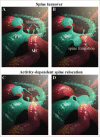Different forms of structural plasticity in the adult olfactory bulb
- PMID: 28596977
- PMCID: PMC5449178
- DOI: 10.1080/23262133.2017.1301850
Different forms of structural plasticity in the adult olfactory bulb
Abstract
The adult olfactory bulb (OB) continuously receives new interneurons that integrate into the functional neuronal network and that play an important role in odor information processing and olfactory behavior. Adult neuronal progenitors are derived from neural stem cells in the subventricular zone (SVZ) bordering the lateral ventricle. They migrate long distances along the rostral migratory stream (RMS) toward the OB where they differentiate into interneurons, mature, and establish synapses with tufted or mitral cells (MC), the principal neurons in the OB. The plasticity provided by both adult-born and pre-existing early-born neurons depends on the formation and pruning of new synaptic contacts that adapt the functioning of the bulbar network to changing environmental conditions. However, the formation of new synapses occurs over a long time scale (hours-days), whereas some changes in environmental conditions can occur more rapidly, requiring a much faster adjustment of neuronal networks. A new form of structural remodeling of adult-born, but not early-born, neurons was recently brought to light. This plasticity, which is based on the activity-dependent relocation of mature spines of GCs toward the dendrites of active principal cells, may allow a more rapid adjustment of the neuronal network in response to quick and persistent changes in sensory inputs. In this mini-review we discuss the different forms of structural plasticity displayed by adult-born and early-born neurons and the possibility that these different forms of structural remodeling may fulfill distinct roles in odor information processing.
Keywords: activity-dependent plasticity; adult neurogenesis; critical period; olfactory bulb; spine relocation; spine turnover; structural plasticity.
Figures


Similar articles
-
The Role of Adult-Born Neurons in the Constantly Changing Olfactory Bulb Network.Neural Plast. 2016;2016:1614329. doi: 10.1155/2016/1614329. Epub 2015 Dec 29. Neural Plast. 2016. PMID: 26839709 Free PMC article. Review.
-
Principal cell activity induces spine relocation of adult-born interneurons in the olfactory bulb.Nat Commun. 2016 Aug 31;7:12659. doi: 10.1038/ncomms12659. Nat Commun. 2016. PMID: 27578235 Free PMC article.
-
Persistent Structural Plasticity Optimizes Sensory Information Processing in the Olfactory Bulb.Neuron. 2016 Jul 20;91(2):384-96. doi: 10.1016/j.neuron.2016.06.004. Epub 2016 Jun 30. Neuron. 2016. PMID: 27373833 Free PMC article.
-
The functional significance of newly born neurons integrated into olfactory bulb circuits.Front Neurosci. 2014 May 26;8:121. doi: 10.3389/fnins.2014.00121. eCollection 2014. Front Neurosci. 2014. PMID: 24904263 Free PMC article. Review.
-
The Functional Role of Olfactory Bulb Granule Cell Subtypes Derived From Embryonic and Postnatal Neurogenesis.Front Mol Neurosci. 2018 Jul 5;11:229. doi: 10.3389/fnmol.2018.00229. eCollection 2018. Front Mol Neurosci. 2018. PMID: 30034321 Free PMC article. Review.
Cited by
-
Running-Activated Neural Stem Cells Enhance Subventricular Neurogenesis and Improve Olfactory Behavior in p21 Knockout Mice.Mol Neurobiol. 2019 Nov;56(11):7534-7556. doi: 10.1007/s12035-019-1590-6. Epub 2019 May 6. Mol Neurobiol. 2019. PMID: 31062248
-
"Till Death Do Us Part": A Potential Irreversible Link Between Aberrant Cell Cycle Control and Neurodegeneration in the Adult Olfactory Bulb.Front Neurosci. 2018 Mar 9;12:144. doi: 10.3389/fnins.2018.00144. eCollection 2018. Front Neurosci. 2018. PMID: 29593485 Free PMC article. Review.
-
Maturation of the Olfactory Sensory Neuron and Its Cilia.Chem Senses. 2020 Dec 5;45(9):805-822. doi: 10.1093/chemse/bjaa070. Chem Senses. 2020. PMID: 33075817 Free PMC article. Review.
-
Defining the Adult Neural Stem Cell Niche Proteome Identifies Key Regulators of Adult Neurogenesis.Cell Stem Cell. 2020 Feb 6;26(2):277-293.e8. doi: 10.1016/j.stem.2020.01.002. Cell Stem Cell. 2020. PMID: 32032526 Free PMC article.
-
Olfactory Dysfunction in Neurodegenerative Diseases.Curr Allergy Asthma Rep. 2018 Jun 15;18(8):42. doi: 10.1007/s11882-018-0796-4. Curr Allergy Asthma Rep. 2018. PMID: 29904888 Review.
References
-
- Alonso M, Lepousez G, Sebastien W, Bardy C, Gabellec MM, Torquet N, Lledo PM. Activation of adult-born neurons facilitates learning and memory. Nat Neurosci 2012; 15:897-904; PMID:22581183; http://dx.doi.org/10.1038/nn.3108 - DOI - PubMed
-
- Araya R, Vogels TP, Yuste R. Activity-dependent dendritic spine neck changes are correlated with synaptic strength. Proc Natl Acad Sci U S A 2014; 111:2895-2904; http://dx.doi.org/10.1073/pnas.1321869111 - DOI - PMC - PubMed
-
- Batista-Brito R, Close J, Machold R, Fishell G. The distinct temporal origins of olfactory bulb interneuron subtypes. J Neurosci 2008; 28:3966-3975; PMID:18400896; http://dx.doi.org/10.1523/JNEUROSCI.5625-07.2008 - DOI - PMC - PubMed
-
- Belnoue L, Grosjean N, Abrous DN, Koehl M. A critical time window for the recruitment of bulbar newborn neurons by olfactory discrimination learning. J Neurosci 2011; 31:1010-1016; PMID:21248125; http://dx.doi.org/10.1523/JNEUROSCI.3941-10.2011 - DOI - PMC - PubMed
-
- Bergami M, Vignoli B, Motori E, Pifferi S, Zuccaro E, Menini A, Canossa M. TrkB signaling directs the incorporation of newly generated periglomerular cells in the adult olfactory bulb. J Neurosci 2013; 33:11464-11478; PMID:23843518; http://dx.doi.org/10.1523/JNEUROSCI.4812-12.2013 - DOI - PMC - PubMed
Publication types
LinkOut - more resources
Full Text Sources
Other Literature Sources
Miscellaneous
